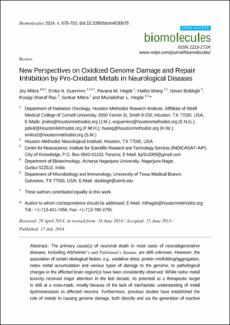New perspectives on oxidized genome damage and repair inhibition by pro-oxidant metals in neurological diseases
Fecha
2014-07-17Autor
Mitra, Joy
Guerrero, Erika N
Hegde, Pavana M
Wang, Haibo
Boldogh, Istvan
Rao, KS Jagannatha
Mitra, Sankar
Hegde, Muralidhar L
Metadatos
Mostrar el registro completo del ítemResumen
The primary cause (s) of neuronal death in most cases of neurodegenerative diseases, including Alzheimer’s and Parkinson’s disease, are still unknown. However, the association of certain etiological factors, eg, oxidative stress, protein misfolding/aggregation, redox metal accumulation and various types of damage to the genome, to pathological changes in the affected brain region (s) have been consistently observed. While redox metal toxicity received major attention in the last decade, its potential as a therapeutic target is still at a cross-roads, mostly because of the lack of mechanistic understanding of metal dyshomeostasis in affected neurons. Furthermore, previous studies have established the role of metals in causing genome damage, both directly and via the generation of reactive oxygen species (ROS), but little was known about their impact on genome repair. Our recent studies demonstrated that excess levels of iron and copper observed in neurodegenerative disease-affected brain neurons could not only induce genome damage in neurons, but also affect their repair by oxidatively inhibiting NEIL DNA glycosylases, which initiate the repair of oxidized DNA bases. The inhibitory effect was reversed by a combination of metal chelators and reducing agents, which underscore the need for elucidating the molecular basis for the neuronal toxicity of metals in order to develop effective therapeutic approaches. In this review, we have focused on the oxidative genome damage repair pathway as a potential target for reducing pro-oxidant metal toxicity in neurological diseases.
Colecciones
Ítems relacionados
Mostrando ítems relacionados por Título, autor o materia.
-
New Perspectives on Oxidized Genome Damage and Repair Inhibition by Pro-Oxidant Metals in Neurological Diseases
Mitra, Joy; Guerrero, Erika N; Hegde, Pavana M; Wang, Haibo; Boldogh, Istvan; Rao, Kosagi Sharaf; Mitra, Sankar; Hegde, Muralidhar L (2014-07-17)The primary cause(s) of neuronal death in most cases of neurodegenerative diseases, including Alzheimer’s and Parkinson’s disease, are still unknown. However, the association of certain etiological factors, e.g., oxidative ... -
New Perspectives on Oxidized Genome Damage and Repair Inhibition by Pro-Oxidant Metals in Neurological Diseases
Mitra, Joy; Guerrero, Erika N.; Hegde, Pavana M.; Wang, Haibo; Boldogh, Istvan; Sharaf Rao, Kosagi; Mitra, Sankar; Hegde, Muralidhar L. (biomolecules, 2014-07-17)The primary cause(s) of neuronal death in most cases of neurodegenerative diseases, including Alzheimer’s and Parkinson’s disease, are still unknown. However, the association of certain etiological factors, e.g., oxidative ... -
α-Synuclein misfolding versus aggregation relevance to Parkinson’s disease: Critical assessment and modeling
Berrocal, Ruben; Vasquez, Velmarini; Rao Krs, Sambasiva; Gadad, Bharathi S; Rao, KS Jagannatha (2015-06-01)α-Synuclein, an abundant and conserved presynaptic brain protein, is implicated as a critical factor in Parkinson’s disease (PD). The aggregation of α-synuclein isbelieved to be a critical event in the isease process. ...

